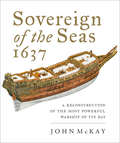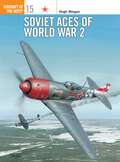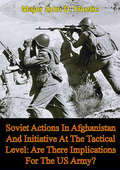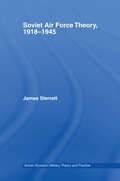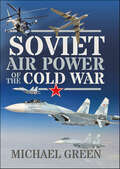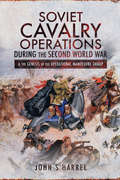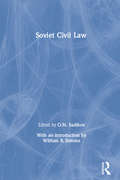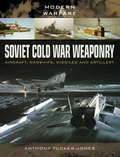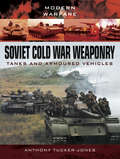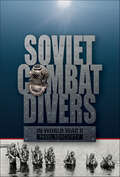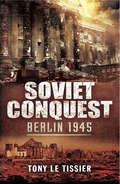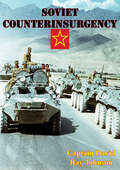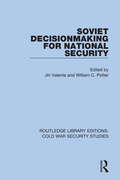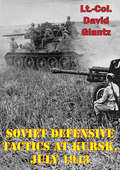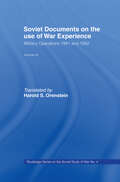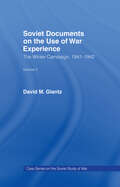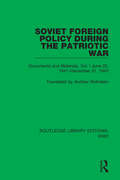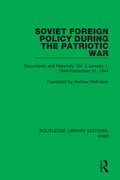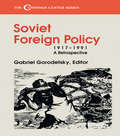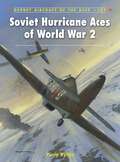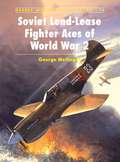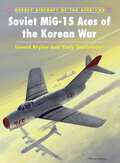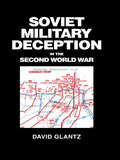- Table View
- List View
Sovereign of the Seas, 1637: A Reconstruction of the Most Powerful Warship of Its Day
by John McKay“McKay’s artful renderings provide a fitting tribute to this amazing vessel and those who participated in her planning and construction.” —Pirates and PrivateersSovereign of the Seas was the most spectacular, extravagant and controversial warship of the early seventeenth century. The ultimate royal prestige project, whose armament was increased by the King’s decree to the unheard-of figure of 100 guns, the ship finally cost the equivalent of ten more conventional warships. A significant proportion of this total was spent on her gilded decoration, which gave the ship a unique combination of firepower and visual impact in battle that led her Dutch opponents to dub her the “Golden Devil.” It is unsurprising that such a high-profile ship should be well-documented, but there are no contemporary plans and much of the visual evidence is contradictory. In this book, John McKay sets out to analyze the data and reconstruct the design and appearance of the ship in a degree of detail never previously attempted. The results are presented as a folio of superbly drafted plans, isometric drawings and colored renderings, covering every aspect of the design from the hull form to the minutiae of sails and rigging. Each section is accompanied by an explanatory text, setting out the rationale for his conclusions, so the book will be of value to historians of the period as well as providing superb reference for any modeler tackling of one of the most popular of all sailing ship subjects.“A magnificent book on a magnificent ship.” —Nautical Research Journal“Very few books of warships contain the level of detail provided here.” —Firetrench
Soviet Aces of World War 2
by John Weal Hugh MorganNo single volume in English has ever appeared in the West dealing with this intriguing subject area, but now that restrictions have relaxed in the former Soviet Union, records of the deeds of the elite pilots of the various Soviet Air Forces are coming to light. Although initially equipped with very poor aircraft, and robbed of effective leadership thanks as much to Stalin's purges in the late 1930s as to the efforts of the Luftwaffe, Soviet fighter pilots soon turned the tables through the use of both lend-lease aircraft like the Hurricane, Spitfire, P-39 and P-40, and home-grown machines like the MiG-3, LaGG-3/5, Lavochkin La-5/7/9 and the Yak-1/3.
Soviet Actions In Afghanistan And Initiative At The Tactical Level: Are There Implications For The US Army?
by Major John D. FrketicThis monograph examines the Soviet experience in Afghanistan (1979-1988) in terms of Soviet Army tactics and organization for combat. Throughout the decade of the 1970's, U.S. perceptions of Soviet ground force tactics stressed a general lack of initiative and flexibility in their military doctrine. In the 1980's a re-evaluation of Soviet thinking occurred which saw greater flexibility at the operational and strategic levels If the experience in Afghanistan has shown that set-piece tactics will not work in all types of warfare, and the Soviets are able to incorporate higher levels of initiative and flexibility into their tactical doctrine, then the U.S. may be required to refocus its training away from the stylized Soviet enemy.This study begins with a background discussion of Soviet historical involvement in Afghanistan to include counter-insurgency experience in their southwestern border area. It then covers the actual invasion and units employed with emphasis on their pre-deployment status and subsequent performance. The following section divides the war into four phases to ease understanding. The monograph subsequently looks at lessons learned and principles reaffirmed from both the Soviet and U.S. perspective. A key feature is the need the Soviets apparently feel for Western style initiative and flexibility at lower command levels (battalion, company and platoon), and how this is inconsistent with their culture and system of command and control.
Soviet Air Force Theory, 1918-1945 (Soviet (Russian) Study of War)
by James SterrettThis new book examines the development of Soviet thinking on the operational employment of their Air Force from 1918 to 1945, using Soviet theoretical writings and contemporary analyses of combat actions.
Soviet Air Power of the Cold War
by Michael Green"...a praiseworthy examination of the evolution of the Soviet air force throughout the Cold War." — Journal of Military HistoryAt the peak of the Cold War in the 1950s the Soviet Union possessed some 12,000 aircraft, making it the largest air force of all the protagonists. By the 1990s this had declined to around 8,000, the reduction largely reflecting the increase in aircraft capability. As well as fighters and bombers, the Soviet inventory included trainers, transports, seaplanes, electronic warfare and ground attack aircraft, as well as an impressive helicopter fleet, notably the Mi-24 ‘Hind’ gunship and the massive Homer transport. The Tu-4 ‘Bull’ was the first Russian nuclear-capable bomber, a copy of the US B-29, which was followed by their range of jet bombers, the Il-28 ‘Beagle’, Tu-16 ‘Badger’ and M-4 ‘Bison’. The prop driven Tu-20 ‘Bear’ and its successors including the Tu-22 ‘Backfire’ and finally the Tu-160 ‘Backfire’, were all formidable. The jet-engined MiG-15 fighter entered service in 1948 and proved itself during the Korean War. The MiG-17, MiG-19 and MiG-21 followed . Ground-attack aircraft included the Su-7 ‘Fitter’ and M-23 ‘Flogger’. The 1970s saw the MiG-25 ‘Foxbat’ interceptor, followed by the MiG-29 ‘Fulcrum’ and Su-27 ‘Flanker’, coming into service. All these aircraft and many more are authoritatively described and vividly illustrated in this comprehensive work.
Soviet Cavalry Operations During the Second World War: & the Genesis of the Operational Manoeuvre Group
by John S. HarrelThe author of The Nisibis War analyzes the Red Army&’s usage of horse-mounted units along the Soviet-German Eastern Front during World War II. While the development of tanks had largely led to the replacement of cavalry in most armies by 1939, the Soviets retained a strong mounted arm. In the terrain and conditions of the Eastern Front, they were able to play an important role denied them elsewhere. John Harrel shows how the Soviets developed a doctrine of deep penetration, using cavalry formations to strike into the Axis rear, disrupting logistics and lines of communication, encircling and isolating units. Interestingly he also shows that this doctrine did not stem from the native cavalry tradition of the steppe but from the example of the American Civil War. The American approach was copied by the Russians in WWI and the Russian Civil War, refined by the Soviets in the early stages of World War Two, and perfected during the last two years of the war. The Soviet experience demonstrated that deep operations (cavalry raids) against enemy rear echelons set the conditions for victory. Although the last horse-mounted units disappeared in the 1950s, their influence led directly to the formation of the Operational Manoeuvre Groups that, ironically, faced U.S. forces in the Cold War. &“An expansive analysis of the technical, tactical and operational employment of Soviet cavalry against the Germans and their Axis allies. For practitioners who want to understand the history and development, the book is a goldmine of overlooked campaigns and actions . . . . The book&’s dense and detailed presentation makes it valuable to operational planners and those interested in the Soviet-German war.&” —ARMOR Magazine
Soviet Civil Law
by O.N. SadikovThis volume is an unabridged translation of the textbook ‘Soviet Civil Law’, originally published in 1983 under the auspices of the USSR Ministry of Justice. Edited by Professor O.N. Sadikov, the work includes contributions from nine Soviet legal scholars
Soviet Cold War Weaponry: Aircraft, Warships And Missiles (Modern Warfare)
by Anthony Tucker-Jones"In this companion volume to his photographic history of Soviet tanks and armoured vehicles, Anthony Tucker-Jones provides a visual guide to the vast array of aircraft, warships and missiles the Soviet armed forces deployed at the height of the Cold War. Although the superpowers never came to blows, the so-called 'Cold War' was far from cold, with numerous 'hot' proxy wars being fought in Africa and the Middle East. All these conflicts employed Soviet weaponry which has been captured in action in the colour and black-and-white photographs selected for this book. Between the 1950s and 1980s Soviet and Warsaw Pact countries churned out thousands of weapons ready for the Third World War. They also embarked on a technological arms race with NATO in an attempt to counter each new piece of equipment as it appeared. The MiG fighters, the Badger and Backfire bombers, the nuclear submarines have achieved almost iconic status, but, as Anthony Tucker-Jones's book shows, there was much more to the Soviet armoury than these famous weapons. Much of it, despite its age, remains in service with armies, guerrilla forces and terrorist organizations around the world today."
Soviet Cold War Weaponry: Tanks and Armoured Vehicles (Modern Warfare)
by Anthony Tucker-JonesThe T-54, T-62 and T-72 main battle tanks along with the personnel carriers, assault guns, self-propelled guns and anti-tank missiles that are illustrated in this photographic history represent the high point in the design and manufacture of armoured vehicles by the Soviet Union during the Cold War. Although the superpowers never came to blows, the 'Cold War' was far from cold, as numerous 'hot' proxy wars were fought in Africa and the Middle East, and these conflicts employed the Soviet weaponry that is shown in action in the colour and black-and-white photographs selected for this book.Between the 1950s and 1980s Soviet and Warsaw Pact countries produced thousands of tanks and armoured vehicles ready for the Third World War. They embarked on a technological arms race with the NATO allies in an attempt to counter each new piece of equipment as it appeared in service. Much of this Soviet weaponry has achieved almost iconic status and, despite its age, remains in service with armies, guerrilla forces and terrorist organizations around the world today. It is also of enduring interest to collectors, re-enactors and modellers who are fascinated by the military equipment of the late twentieth century.
Soviet Combat Divers in World War II
by Pavel BorovikovRare look at the role and place of Soviet combat divers in World War II
Soviet Conquest: Berlin 1945
by Tony Le TissierHow did top Red Army commanders see the assault on Berlin in 1945 what was their experience of the last, terrible battle of the Second World War in Europe? Personal accounts by the most famous generals involved Zhukov, Koniev and Chuikov have been published in English, but the recollections of their principal subordinates haven't been available in the west before, and it is their role in the final Soviet offensive that is the focus of Tony Le Tissier's fascinating book. These were the officers who were responsible for the execution of the Red Army's plan for the assault, in immediate touch with the troops on the front line of the advance. They saw most clearly where the operation succeeded and where it failed. Their recollections, publication of which was long banned in the Soviet Union, throw a new light on the course of battle and on the inner workings of the Red Army command in the final phase of the conflict.
Soviet Counterinsurgency
by Captain David Ray JohnsonThe aim of this paper is to determine the presence or absence of a Soviet doctrine of counterinsurgency and to identify the historical patterns of Soviet counterinsurgency. The development of these central themes should contribute to the secondary goals of the paper; first, to establish a fuller basis of comparison than is currently used in examination of Soviet and Soviet-advised counterinsurgent campaigns, and second, to add some historical depth to the developing body of work on Soviet counterinsurgency. This should allow for some useful generalizations about the Soviet approach to counterinsurgent warfare to be derived.Counterinsurgency became a preoccupation of the U.S. military during the late fifties and early sixties. The U.S. involvement in Vietnam sustained interest in counterinsurgency and new challenges to U.S. interests in Latin America, Asia, and Africa have renewed attention to issues of counterinsurgency in the eighties. Although the insurgents (primarily the Central Asian Basmachi), and comparative surveys of the counterinsurgency campaigns of the Soviets in Afghanistan and various Soviet allies fighting insurgents since 1975. For the purpose of establishing the patterns of Soviet counterinsurgency the limited number of cases in the first two approaches is too narrow. Although the third approach examines more cases, it mixes dissimilar cases and blurs distinctions between Soviet methods of counterinsurgency and the methods of Soviet advised militaries fighting insurgencies.
Soviet Decisionmaking for National Security (Routledge Library Editions: Cold War Security Studies #47)
by Jiri Valenta; William C. PotterThis book, first published in 1984, analyses the critically important Cold War issue of the Soviet national security decision-making process dealing with weapons acquisition, arms control and the application of military force. It conceptualises Soviet decision-making for national security from Stalinist antecedents to 1980s modes, and examines the problems of decision-making concerning weapons development, defence research and development and SALT negotiations. It also focuses on the decision-making processes which led to the use or threatened use of military force in Czechoslovakia (1968), the Middle East (1973) and Afghanistan (1979).
Soviet Defense Against Operation Barbarossa: A Possible Model For Future Soviet Defensive Doctrine
by Major Terry B. WilsonThis monograph examines the historic attack by Adolf Hitler's Germany against the Soviet defenses in 1941. It examines actions of both armed forces to analyze what went wrong and what went right for each side. It focuses on Soviet defenses to determine the usefulness of defensive planning and operations of 1941 to today's announced policy of reasonable sufficiency and non-offensive defense. The monograph begins with an analysis of current Soviet military doctrine and President Gorbachev's stated political ideal of 'reasonable sufficiency' and his goal for the military of a doctrine of 'non-offensive defense.' The monograph continues with an examination of Soviet military theory, an historical analysis of Operation Barbarossa, and an analysis of the usefulness of the campaign for modern doctrinal development. The Soviets use historical models in the scientific development of their doctrine.
Soviet Defensive Tactics At Kursk, July 1943
by Colonel David M GlantzIn his classic work, On War, Carl von Clausewitz wrote, "As we shall show, defense is a stronger form of fighting than attack." A generation of nineteenth century officers, nurtured on the study of the experiences of Napoleon and conditioned by the wars of German unification, had little reason to accept that view. The offensive spirit swept through European armies and manifested itself in the regulations, plans, and mentality of those armiehe events of 1939, 1940, and 1941 in Poland, France, and Russia respectively again challenged Clausewitz' claim of the superiority of the defense and prompted armies worldwide to frantically field large armored forces and develop doctrines for their use. While blitzkrieg concepts ruled supreme, it fell to that nation victimized most by those concepts to develop techniques to counter the German juggernaut. The Soviets had to temper a generation of offensive tradition in order to marshal forces and develop techniques to counter blitzkrieg. In essence, the Soviet struggle for survival against blitzkrieg proved also to be a partial test of Clausewitz' dictum. In July 1943, after arduous months of developing defensive techniques, often at a high cost in terms of men and material, the Soviets met blitzkrieg head-on and proved that defense against it was feasible. The titanic, grinding Kursk operation validated, in part, Clausewitz' views. But it also demonstrated that careful study of force organization and employment and application of the fruits of that study can produce either offensive or defensive victory. While on the surface the events of Kursk seemed to validate Clausewitz' view, it is often forgotten that, at Kursk, the Soviets integrated the concept of counteroffensive into their grand defensive designs. Thus the defense itself was meaningless unless viewed against the backdrop of the renewed offensive efforts and vice versa. What Kursk did prove was that strategic, operational, and tactical defenses could counter blitzkrieg.
Soviet Documents on the Use of War Experience: Volume Three: Military Operations 1941 and 1942 (Soviet (Russian) Study of War)
by Harold S. Orenstein David M. GlantzThe Soviet Study of War" series examines the lessons Soviet military theorists and commanders learned from the study of their own military experience. These are translations of Soviet documents.
Soviet Documents on the Use of War Experience: Volume Two: The Winter Campaign, 1941-1942 (Soviet (Russian) Study of War)
by Harold S. OrensteinThe Soviet Study of War" series examines the lessons Soviet military theorists and commanders learned from the study of their own military experience. These are translations of Soviet documents.
Soviet Field Fortifications 1941-45
by Gordon Rottman Chris TaylorFrom June 1941, the Soviets were forced to undertake large-scale defensive operations in the face of the overwhelming German blitzkrieg assault, operations which ran counter to their preference for highly mobile, offensive warfare. Lessons were quickly learned across a wide variety of terrain and climates, including the open steppes, dense forests, wooded swamps, cities, and in snow and ice, where the availability of construction materials differed greatly. The first to cover this topic in the English language and containing detailed information about the trenches, bunkers, observation posts, and weapon positions, this book examines field fortifications built from local materials by infantrymen, as well as their use of mines, field camouflage techniques, and construction tools. It provides a first fascinating insight into Russian defensive attempts against the overwhelming might of the German Army.
Soviet Foreign Policy During the Patriotic War: Documents and Materials. Vol. I June 22, 1941–December 31, 1943 (Routledge Library Editions: WW2 #30)
by Andrew RothsteinThis book, first published in 1946, collects documents illustrating the foreign policy of the Soviet Union during the Second World War. They show how the fighting alliance of the USSR, Britain and the USA came into being and grew stronger, how relations were restored with other anti-Nazi countries, and how diplomatic relations were extended between the USSR and hitherto un-connected countries. The collection of three parts of translated documents: statements and speeches made by Stalin; documents, treaties, agreements; appendices including press statements and telegrams.
Soviet Foreign Policy During the Patriotic War: Documents and Materials. Vol. II January 1, 1944–December 31, 1944 (Routledge Library Editions: WW2 #31)
by Andrew RothsteinThis book, first published in 1946, collects documents illustrating the foreign policy of the Soviet Union during the Second World War. They show how the fighting alliance of the USSR, Britain and the USA came into being and grew stronger, how relations were restored with other anti-Nazi countries, and how diplomatic relations were extended between the USSR and hitherto un-connected countries. The collection of three parts of translated documents: statements and speeches made by Stalin; documents, treaties, agreements; appendices including press statements and telegrams.
Soviet Foreign Policy, 1917-1991: A Retrospective (Cummings Center Series)
by Gabriel GorodetskyA comprehensive assessment of Soviet relations with the West, set in the context of the emergence of a new Russia. This volume anlayzes the formulation of foreign policy during the period from the first decade of the Bolshevik Revolution, through the gradual erosion of ideological differences.
Soviet Hurricane Aces of World War 2
by Aleksander Rusinov Yuriy RybinFollowing the destruction wrought on the Red Army Air Forces during the first days of Operation Barbarossa in June 1941, the Soviet Union found itself desperately short of fighter aircraft. Premier Josef Stalin duly appealed directly to Prime Minister Winston Churchill for replacement aircraft, and in late 1941 the British delivered the first of 3360 Hurricanes that would be supplied to the Soviet Union under the Lend-Lease agreement. Specifically requested by the USSR, the Hurricanes were quickly thrown into action in early 1942 - the Soviet Air Forces' most difficult year in their opposition to the Luftwaffe. Virtually all the Hurricanes were issued to Soviet fighter regiments in the northern sector of the front, where pilots were initially trained to fly the aircraft by RAF personnel that had accompanied the early Hawker fighters to the USSR. The Hurricane proved to be an easy aircraft to master, even for the poorly trained young Soviet pilots, allowing the Red Army to form quickly a large number of new fighter regiments in the polar area. In spite of a relatively poor top speed, and only a modest rate-of-climb, the Hurricane was the mount of at least 17 Soviet aces.
Soviet Lend-Lease Fighter Aces of World War 2
by George MellingerBy the end of 1941 the Soviet Union was near collapse and its air force almost annihilated, leaving large numbers of surviving pilots with no aircraft to fly. At this juncture the United Kingdom put aside its prewar animosities toward the Communists and despatched several hundred Hurricane fighters despite the fact that at this time the British were still struggling to supply the RAF with modern fighters in North Africa and the Far East. A total of 4300 Hurricanes and Spitfires, as well as several hundred Tomahawks, Kittyhawks and Airacobras, obtained from the USA under Lend-lease, were eventually supplied to the USSR in an attempt to present a Russian defeat. After the United States had entered the war, the Americans extended Lend-lease to include direct supply to the Soviets as well as the British, and among the aircraft sent were almost 10,000 fighters - mainly P-39s, P-40s and P-63s. Although many of these aircraft were outdated when they arrived, and some were not particularly suited to Russian operating conditions, they served when they were needed. A number of Russian pilots became Heroes of the Soviet Union flying Lend-lease aircraft, and many more gained their early experience before converting to their own Yaks and Lavochkins. All of these types, including the Hurricane, remained in active units until the end of the war, and even into the post-war period. The Soviet government tried to play down or conceal the importance of Lend-lease fighters until well into the 1980s, and the pilots who flew them were discriminated against as 'foreigners'. Only in recent years have these pilots felt free to admit what they flew, and now the fascinating story of these men and their heroic achievements can emerge.
Soviet MiG-15 Aces of the Korean War
by Leonid Krylov Yuriy TepsurkaevThe Soviet Union began assisting the People's Republic of China in its establishment of a modern air force in 1950, when Soviet Air Force regiments were sent to train local pilots. China's involvement in the Korean War in late October 1950 inevitably drew Soviet pilots into the war. A total of 52 Soviet pilots scored five or more victories in the Korean War. The history of these covert actions has been a long-buried secret and this book will be the first English publication to detail the only instance when the Cold War between Russia and the US became "hot." This book uncovers Soviet combat experiences during the Korean War from detailed unit histories and rare first-hand accounts. With access to extensive Russian archives, the authors offer an enthralling insight into an air war that has been largely covered up and neglected, illustrated with previously unpublished photographs and detailed full-color profiles.
Soviet Military Deception in the Second World War (Soviet (Russian) Military Theory and Practice #Vol. 1)
by David M. GlantzPublished in 1989, Soviet Military Deception in the Second World War is a valuable contribution to the field of Military & Strategic Studies.
